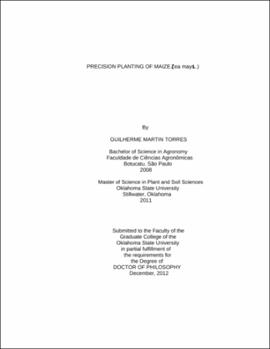| dc.description.abstract | Precision seed placement and the resulting leaf orientation have the potential to influence some of the parameters that controls productivity. The objectives of this work were to evaluate the impact of seed placement and leaf orientation on cumulative intercepted photosynthetic active radiation (CIPAR), radiation use efficiency (RUE), grain yield, and plant-to-plant yield inequality of maize (Zea mays L.). Precision placement of maize used to orient leaf azimuths predominantly across and with the row was compared to conventionally planted seeds with random leaf orientation. Seed placements and leaf orientations were evaluated across plant populations (37050, 49400, 61750, 74100, and 98800 plants ha-1), hybrids with differing canopy architecture (planophile and erectophile), and row configuration (single and twin rows). In 2012, by-plant yield and plant distance were measured and used to evaluate plant-to-plant yield inequality. In Chapter I, results show that CIPAR was higher for seed placements that resulted on across row leaf orientation rather than random. Yield responded positively to improved light interception and under irrigated conditions, precision planting of maize increased yield by 9 to 14% compared to conventionally planted seeds. In Chapter II, estimated CIPAR for leaf orientations were ranked as across-row > random > with-row, but greater RUE was observed for with-row rather than across-row or random leaf orientations. Additionally, across-row and with-row increased yield by 541 and 568 kg ha-1 compared to random leaf orientation. In Chapter III, Lorenz curves and Gini coefficient (G) demonstrated that by-plant yield inequality tended to reduce with precision planting. Lower by-plant yield inequality as indicated by small G coefficient was associated with lower coefficient of variation (CV), lower range, L-skewed, and leptokurtic distributions. Plant-to-plant yield variation expressed by the CV of by-plant yield indicated that seed placement and leaf orientation had little influence on yield variation but plant-to-plant yield variation was positively correlated with plant distance variation (plant distance CV). This work found that precision planting tended to reduce plant-to-plant yield inequality, increase light interception, and promote changes in radiation use efficiency which can result in yield improvement compared to conventionally planted seeds with random leaf orientation. | |
